Blue colors stand out on green vegetation. Some of the atypical or stand-out bugs are those that are at least partially blue.
Various species of the world come in bright or dark blue colors. Even more, some have iridescent blue or metallic blue nuances.
Not particularly rare, the following species of blue bugs may be the easiest to spot.
Table of Contents
1. Blue-green Sharpshooter
Some of the most atypical blue bugs in The United States are those of The Blue-green Sharpshooter species (Graphocephala atropunctata).
This is a type of bug that comes in variable nuances, as its name suggests.
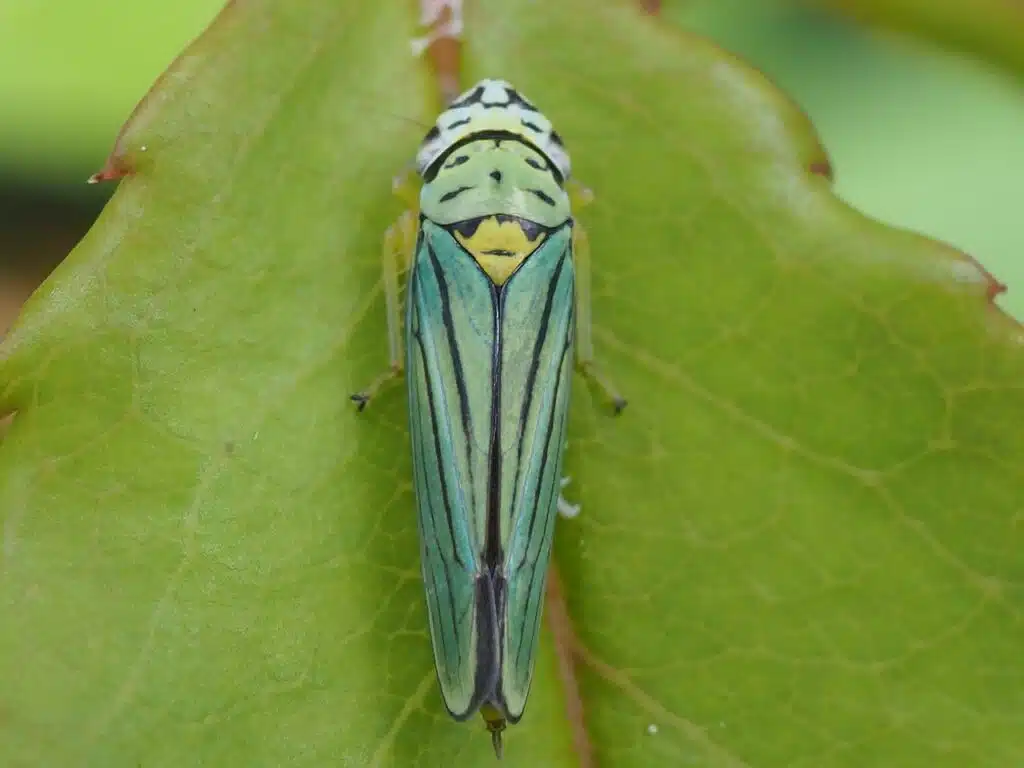
Either blue or yellow, the color of these bugs is impacted by their location. Living in isolated groups, this species can be either green in one location or blue in another.
Riparian areas or zones with vegetation around water in Southern California are the main locations of the blue morph Blue-green Sharpshooter on The West Coast.
This is a species that bears a resemblance to the green morph as both have black veins along their wings.
The blue morph also has white head marks and yellow coloring behind the head.
Blue nuance – bright blue
2. Broad-headed Sharpshooter
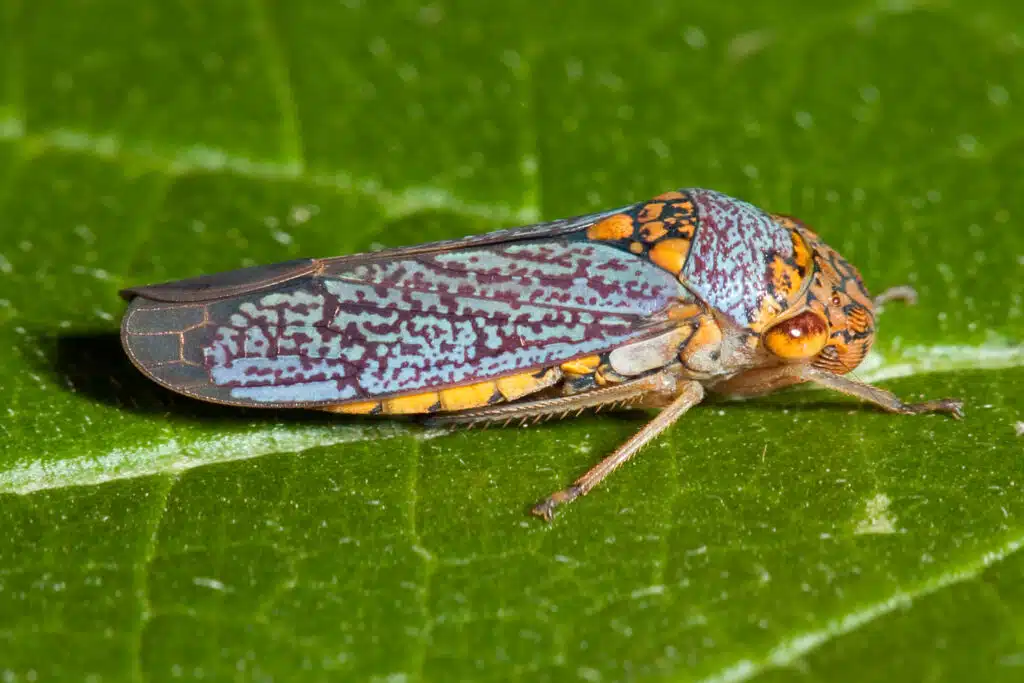
Unlike Blue-green Sharpshooters, Broad-headed Sharpshooters (Oncometopia orbona) live in the Eastern part of The United States.
However, even these blue bugs are one of the most feared species when it comes to grapevine impact. Luckily, both species mostly prefer wild grapevines which they can infest with bacteria.
Broad-headed Sharpshooters come in different colors. These are some of the most common types of bright blue bugs on grapevines in Eastern US territories.
While it can also be black or red-brown, the blue morph of The Broad-headed Sharpshooter is bright and contrasted by black veins and patterns.
Its head is mostly yellow with dark blue to black patterns while the eyes are partly brown and partly yellow.
This bacteria-spreading bug also shows bright yellow ventral coloring.
Blue nuance – bright blue, dark blue
3. Florida Predatory Stink Bug
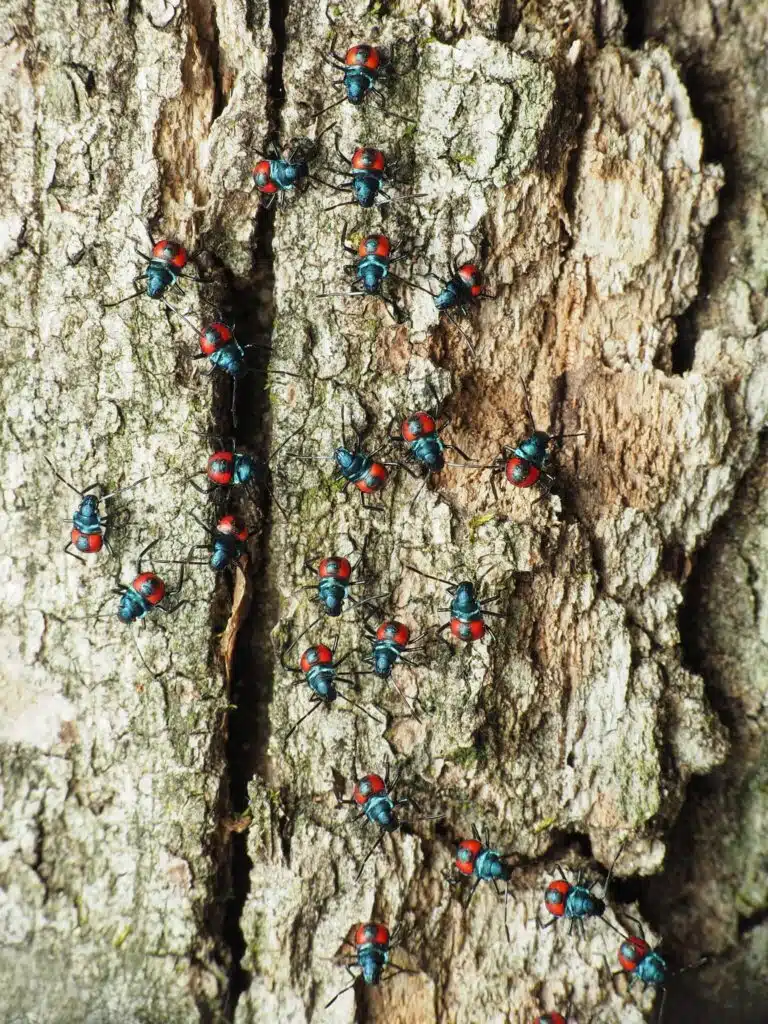
Blue, dark blue, and metallic blue nuances are specific to Florida Predatory Stink Bugs (Euthyrhynchus floridanus). A mostly blue appearance is common in the early growth stages of the nymphs.
These nymphs are mostly metallic blue in their initial growth stages. They show metallic nuances and only grow red patches from the third instar onwards.
While it’s only present in Florida, this is a species of bug with a positive ecosystem impact through its diet.
As predatory bugs, Florida Predatory Stink Bugs feed on small bugs and insects that eat plants and flowers.
However, the rather reduced populations and location of these stink bugs don’t make them as useful as other types of predatory bugs.
Some of the favorite prey of the species include alfalfa weevils and walnut caterpillars.
Blue nuance – metallic dark blue
4. Blue Shield Bug
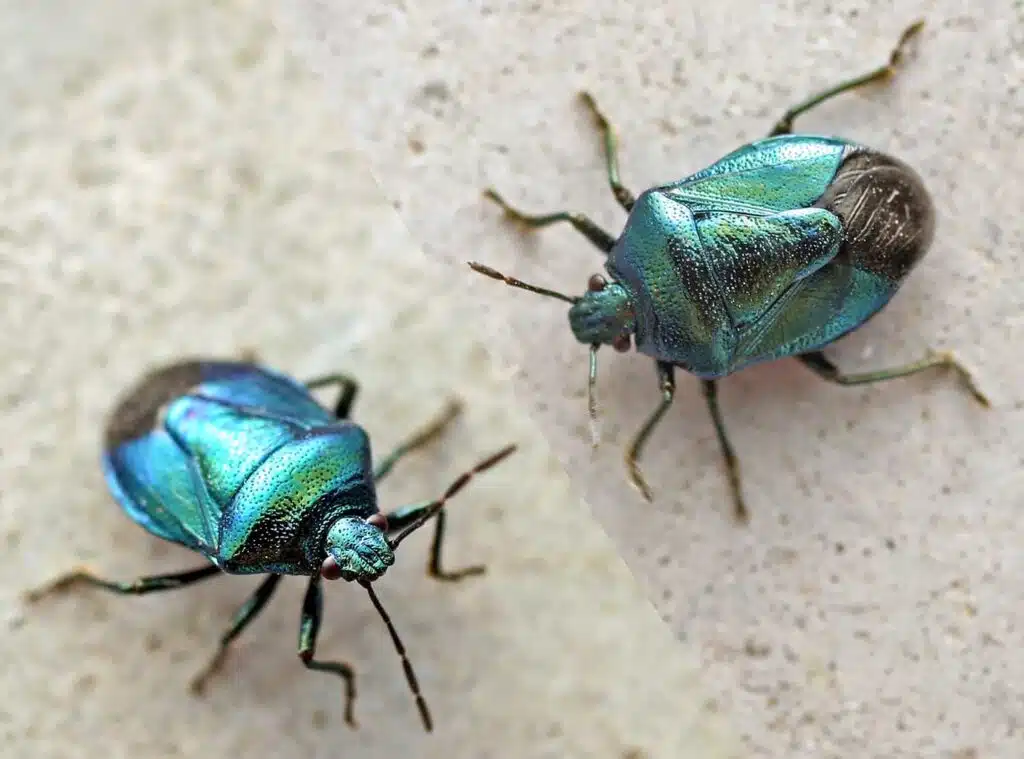
Named after the shape of their bodies, Blue Shield Bugs (Zicrona caerulea) have a metallic blue nuance.
This changes colors with age. As adults, Blue Shield Bugs have bright blue nuances but they are black and red as nymphs.
Reaching a maximum size of 0.3 inches, Blue Shield Bugs are beneficial through pest bug predation.
They are bugs and insects that feed on leaves, including caterpillars.
Blue Shield Bugs are commonly found in woodlands, grasslands next to woodlands, and areas with short vegetation.
Blue nuance – metallic blue
5. Red-bordered Stink Bug
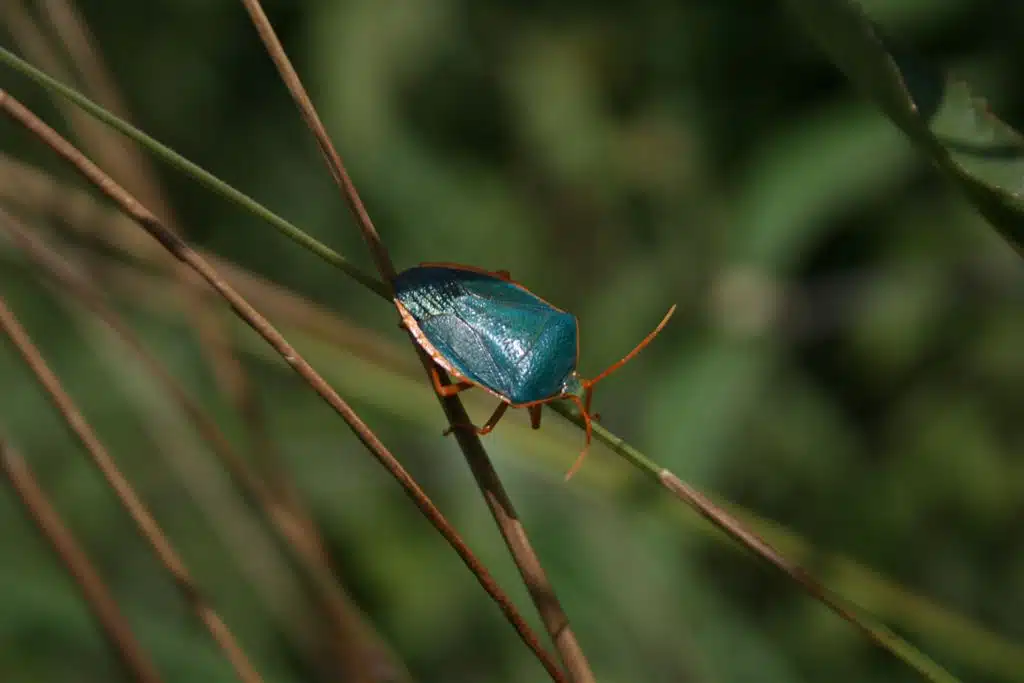
Named after the red-brown borders of its body and its legs, this is a species with turquoise wings and head coloring.
A metallic turquoise color is seen along its wings, with the exception of the black wing tips.
Red-bordered Stink Bugs (Edessa rufomarginata) further stand out with their cream-to-white underbellies.
This is a species found in Central America, with occasional sightings in the Southernmost parts of The United States.
Red-bordered Stink Bugs are further differentiated by their large size and detrimental eating habits.
Growing to an average size of 0.5 inches, these are some of the largest bugs that feed on tobacco leaves.
It is also a common pest of potatoes with a growing presence in other types of crops.
Blue nuance – turquoise
6. Metallic Blue Ladybug
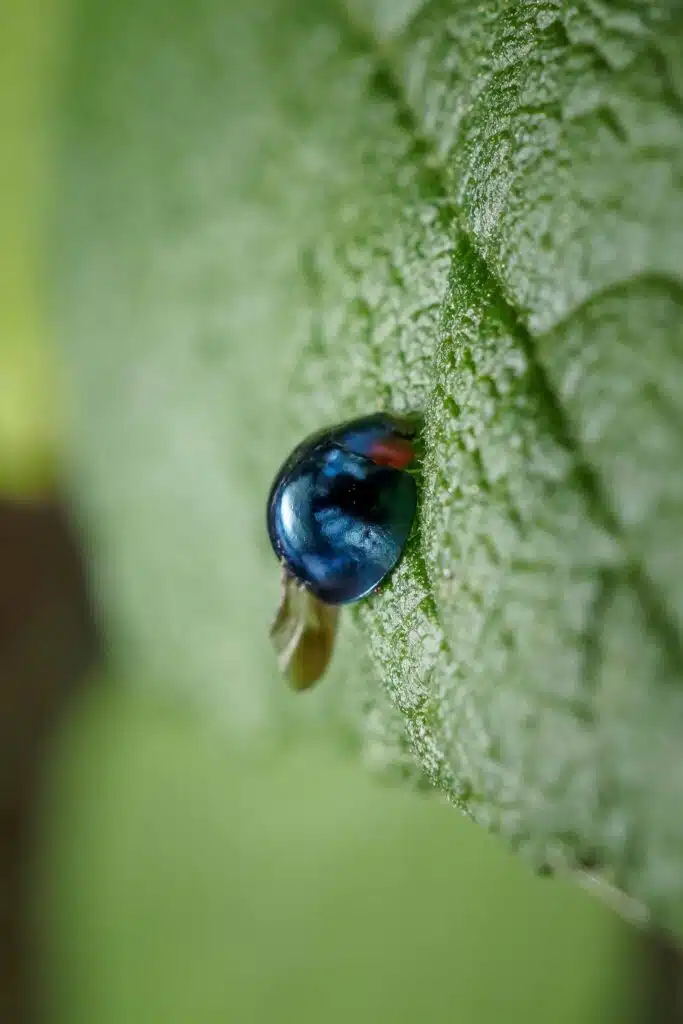
A dark blue metallic color is specific to this type of ladybug. A round-shaped bug, Metallic Blue Ladybugs (Curinus coeruleus) can fly and walk with their 3 pairs of legs.
Seen almost throughout the year with the exception of the coldest months, Metallic Blue Ladybugs are among the beneficial types of blue bugs through their predatory habits.
These blue bugs feed on various detrimental bugs such as those of the psyllidis family.
Such detrimental bugs are found on crops and tree leaves such as apples and pear tree leaves.
As a result, Metallic Blue Ladybugs can be found in these rich foliage locations where they can locate their prey.
While it lays yellow eggs on its host plants, it doesn’t represent a risk to its host leaves.
Blue nuance – metallic blue
7. Blue Fungus Beetle
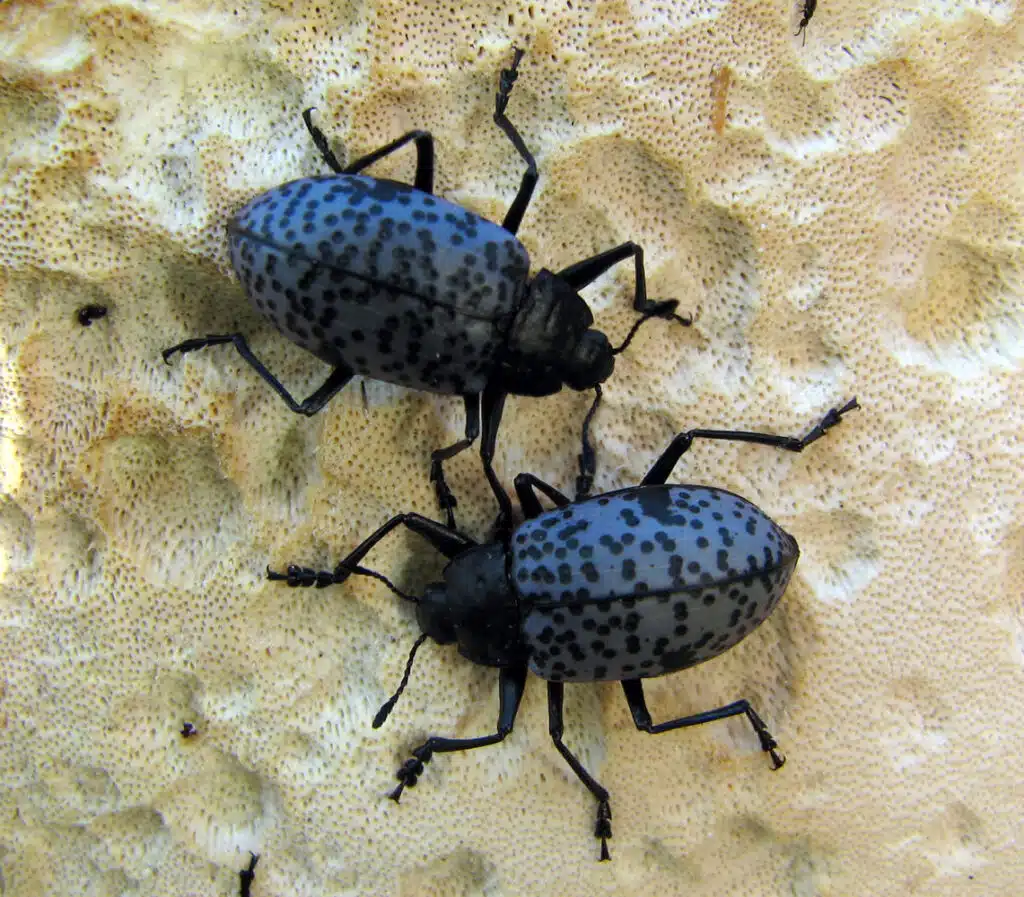
Dominated by a blue appearance, this species (Cypherotylus californicus) has large blue wings and a black head. It shows additional black spots along its wings.
Blue Fungus Beetles have a diverse diet which includes cork fungus, a type of fungus that grows directly on trees.
However, these bugs also thrive on plant nectar which they may resort to in the absence of cork fungus.
Blue Fungus Beetles grow to a size of about 1 inch and may be found in old forests as well as around homes and gardens.
The presence of rotting wood around the yard attracts the species as the fungus it feeds on grows on dead wood.
Blue nuance – dark blue
8. Cobalt Milkweed Beetle
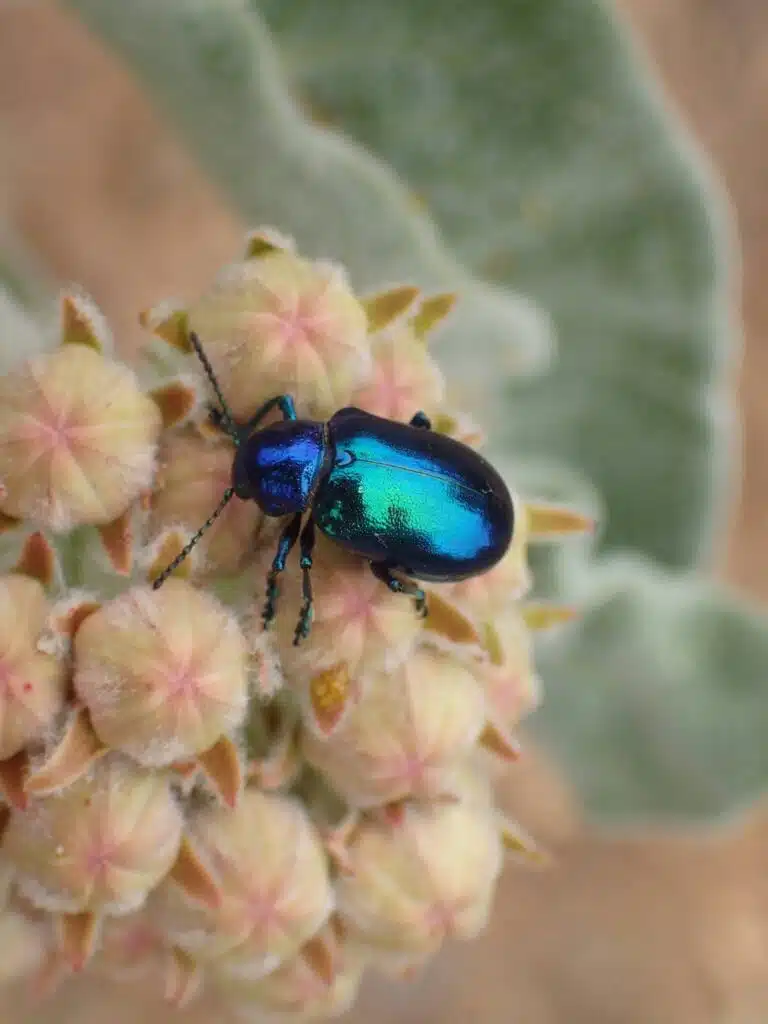
Named after its cobalt blue appearance, this dark beetle (Chrysochus cobaltinus) feeds on various species of milkweed.
The feeding habits of the beetle include leaves and flowers. Since it feeds on weeds, it doesn’t hold a potential pest status.
On occasions such as outbreaks, Cobalt Milkweed Beetles may also eat and land other plants.
They can disperse on wildflowers around milkweed such as on dogbane and other flowering plants.
Found West of The Rocky Mountains, this species has a widespread North American and Central American habitat.
It can be found in Western Canada and Western US territories.
Blue nuance – cobalt blue
9. Desert Ironclad Beetle
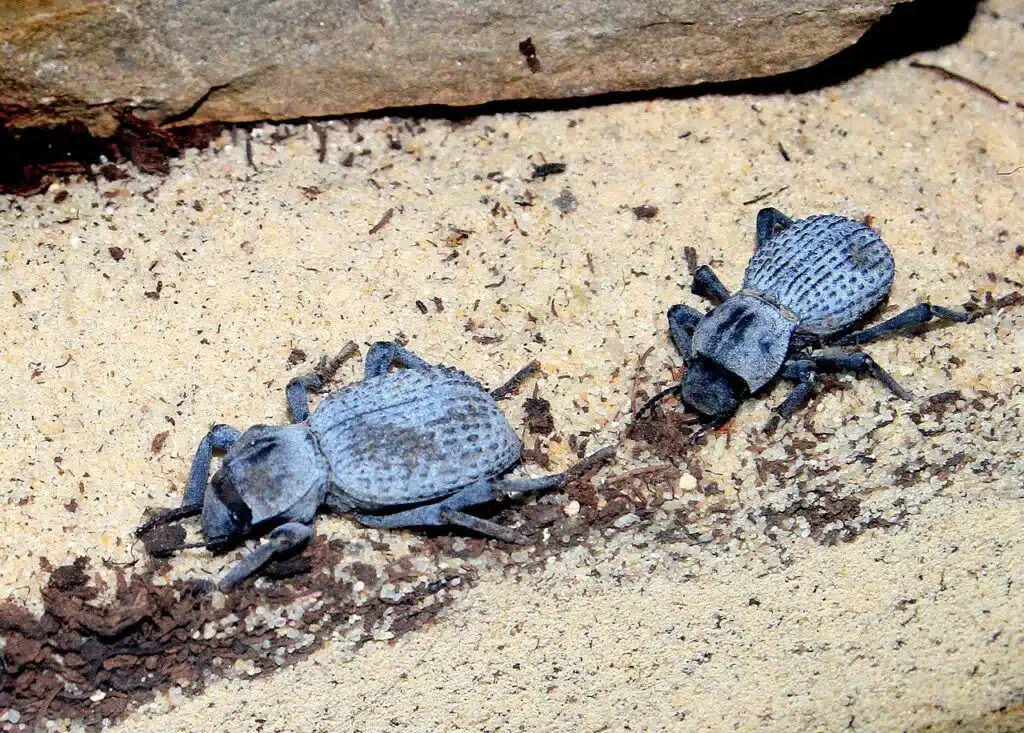
A bright blue or blue-gray color mostly describes the appearance of The Desert Ironclad Beetle (Asbolus verrucosus).
This is a species with a blue abdomen and a blue cephalothorax. Its legs are also blue.
Dark blue or black marks are seen along its body in the form of fine stripes and dots on the abdomen and wide marks on the cephalothorax.
A long-living species found in Western and Southwestern US territories, this is a type of bug that may reach a maximum size of 0.8 inches.
A species seen in captivity due to its rare traits, Desert Ironclad Beetles can play dead.
Those who raise these bugs in captivity may feed them at dawn or later in the evening.
Blue nuance – blue-gray
10. Willow Leaf Beetle
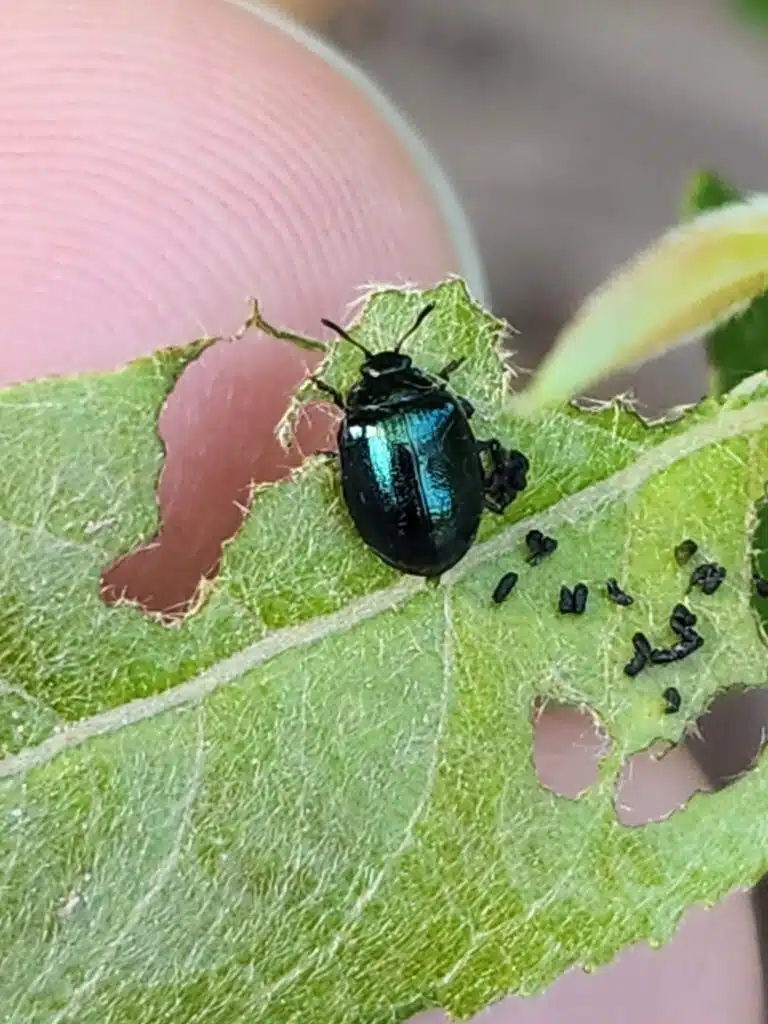
Dark blue to black coloring is specific to Willow Leaf Beetles (Plagiodera versicolora). These types of bugs have uniform coloring and a slightly metallic appearance.
A species dominated by this dark color, these beetles are among the multiple types of bugs that feed on willow and tree leaves.
Found in riparian areas, Willow Leaf Beetles are the bugs that often hide under tree bark during the winter.
Emerging in the spring and summer months, Willow Leaf Beetles start feeding on the softer leaves of willows.
Their eating habits can be highly detrimental if the populations aren’t controlled by common predators such as birds.
Blue nuance – dark blue
11. Flower Lebia Beetle
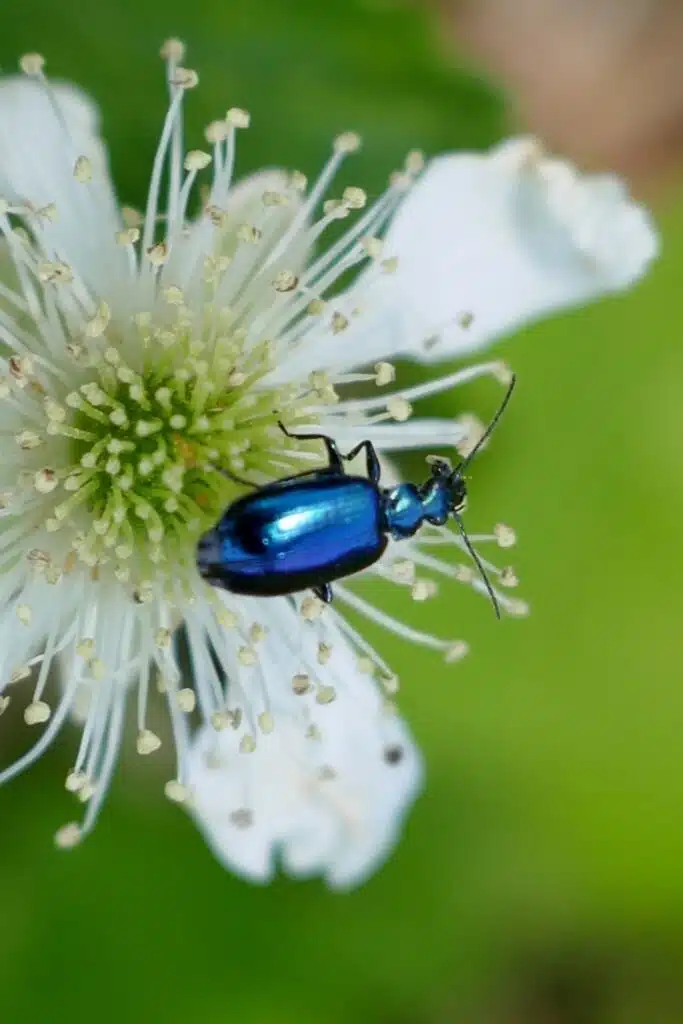
Blue-green colors are specific to Flower Lebia Beetles (Lebia viridis). A species with a glossy appearance, this bug has dark nuances.
Central areas of its body show slight green nuances while the sides of its dorsum are mostly glossy blue.
The elytra and the cephalothorax are both blue-green while the antennae and legs are black.
This bug species has silvery-gray eyes and feeds on flowers.
Various plant species such as those in the sunflower family are among its favorites.
A species that only feeds during the day, Flower Lebia Beetles can be spotted on flowers in gardens.
Blue nuance – blue-green
Further Reading:
12. Thomas’s Two-striped Grasshopper
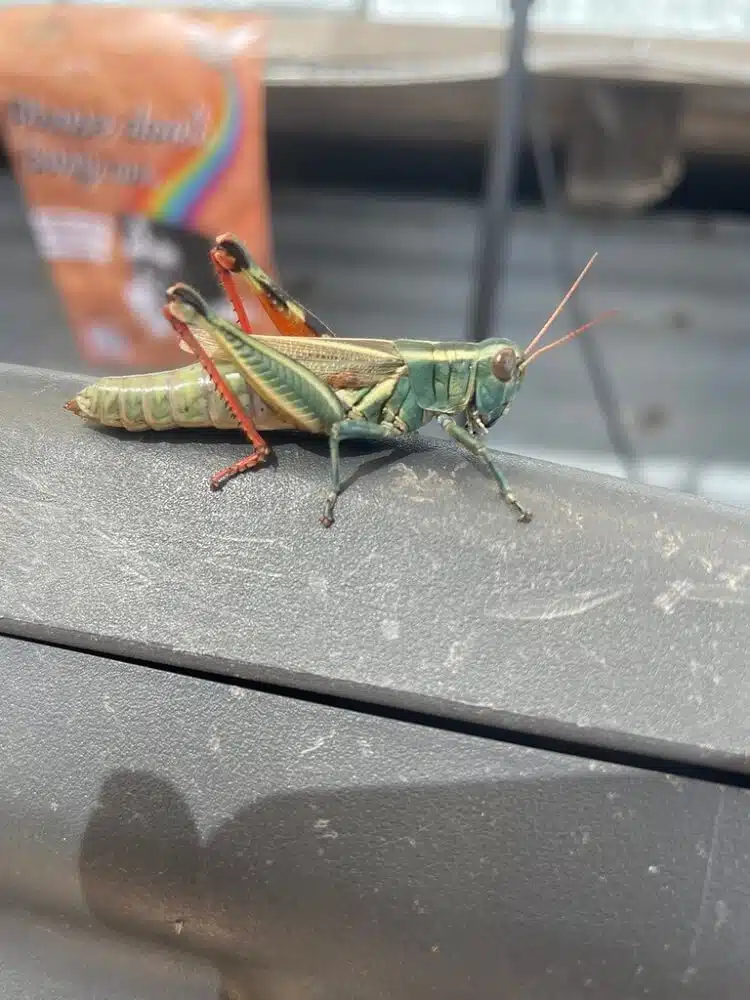
A species native to Central America, Thomas’s Two-striped Grasshoppers (Melanoplus thomasi) have an emerald-blue color.
These types of grasshoppers reach a length of up to several inches and are multicolored.
The area around the head, the body, and the front legs have a blue nuance.
Its wings are gray-brown with slight transparency. Its hind legs are orange-red.
The large eyes of the species are black and contrast with its blue head.
Females of the species may have similar coloring to adults. However, females are mostly white or bright gray with just a few chevron-shaped blue marks on the hind legs.
Blue nuance – emerald-blue
13. Blue Ant
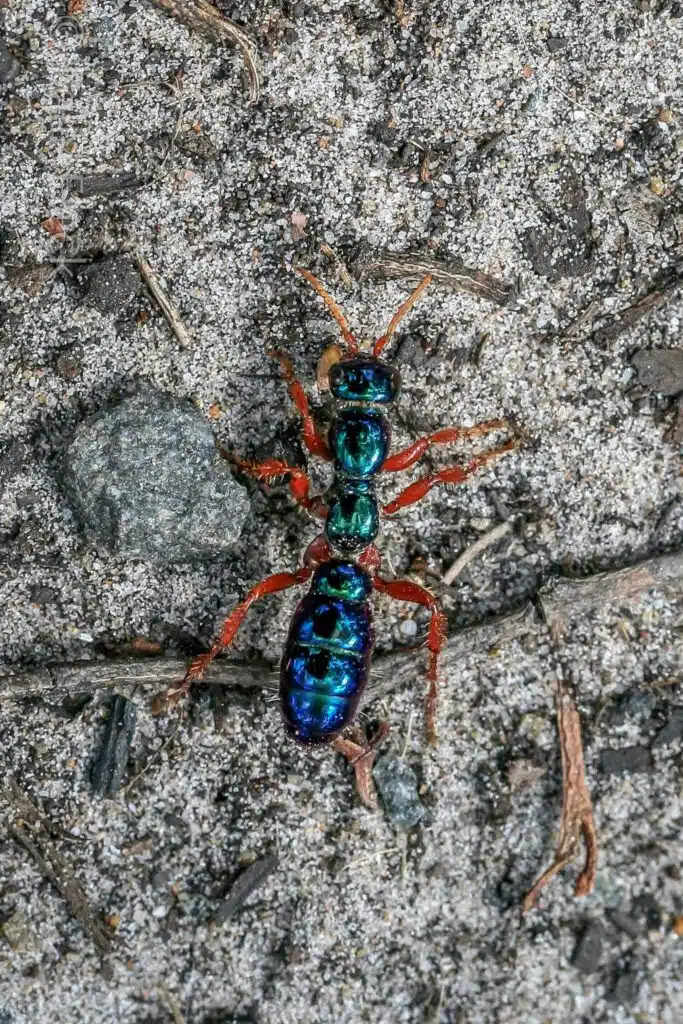
The dark blue coloring is specific to Blue Ants (Diamma bicolor). These types of bugs aren’t ants but wasps that pretend to be ants.
Blue Ants are known for their mimicry efforts to pass as ants to avoid a large number of predators.
They feature a dark blue-green color with red legs and movements that resemble those of ants.
Blue ants don’t have wings like actual wasps as they even mimic the movements and habitat of ground ants.
These types of wasps are further known for their stinging capacity. The sting of Blue Ants is believed to be highly painful and it may even require hospitalization in the case of severe effects.
Blue nuance – dark blue
14. Nearctic Blue Mud-Dauber Wasp
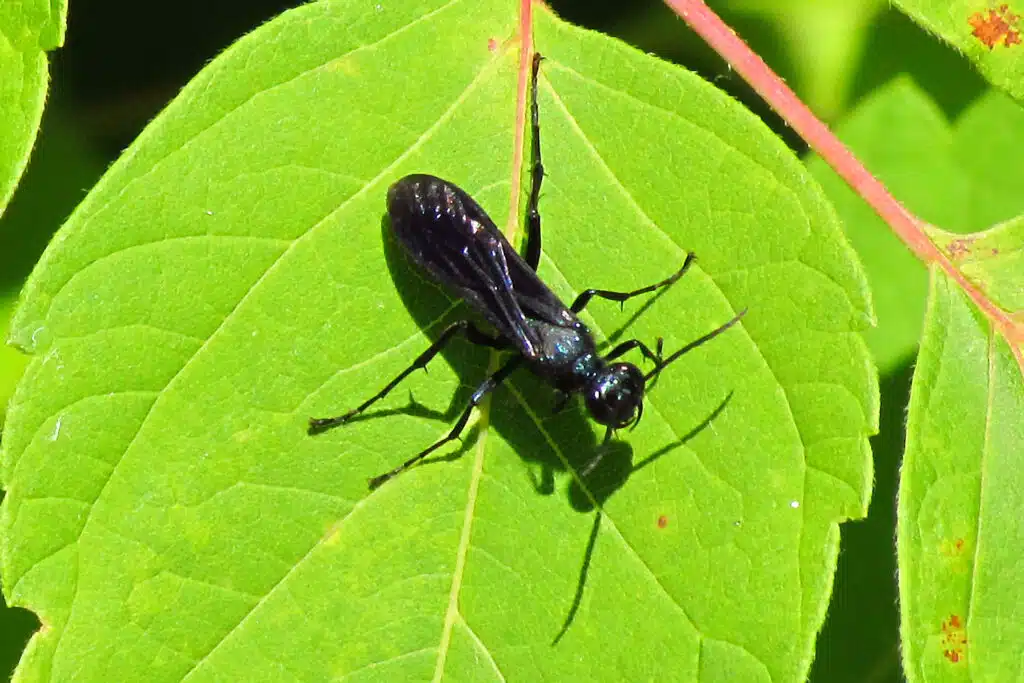
Strong wasps that kill and capture spiders, Nearctic Blue Mud-Dauber Wasps (Chalybion californicum) have a dark blue coloring.
A metallic blue color covers the abdomen and thorax of the species which also has long black wings.
A capable flier, this species of wasp is known for walking as well. It is one of the few species which is identified as a predator of Black Widow spiders.
Black Widows are captured to feed the young back at the nest.
Nearctic Blue Mud-Dauber Wasps are further known as a species that can raid the nests of other wasps.
It can remove the existing eggs of a nest to lay its own eggs which are then provisioned with paralyzed prey such as spiders for the emerging larvae.
Blue nuance – dark blue
15. Steel-Blue Cricket-Hunter Wasp
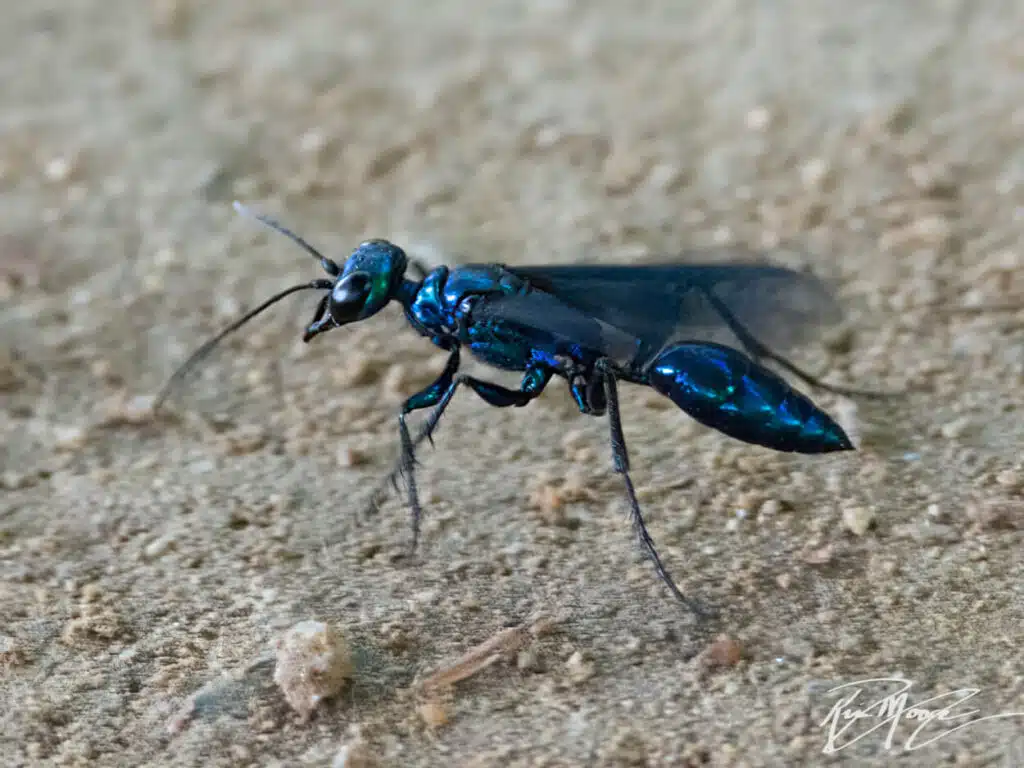
A species of North and Central America, Steel-Blue Cricket-Hunter Wasps (Chlorion aerarium) are among the multiple blue wasps of The Americas.
A glossy blue appearance is characteristic of this species which has uniform coloring.
Steel-blue Cricket-Hunter Wasps are among the species that can paralyze prey such as spiders to provision to their young.
These types of wasps live in the same area as cicada killers. They may even repurpose the nests of other species to lay their own eggs.
Steel-Blue Cricket-Hunter Wasps are also known to live and capture crickets.
They can be found in lawns, gardens, and other common areas where crickets live. Still, these types of predatory wasps feed on plant nectar and show no particular aggression towards humans.
Blue nuance – dark blue
16. Metallic Bluish-Green Cuckoo Wasp
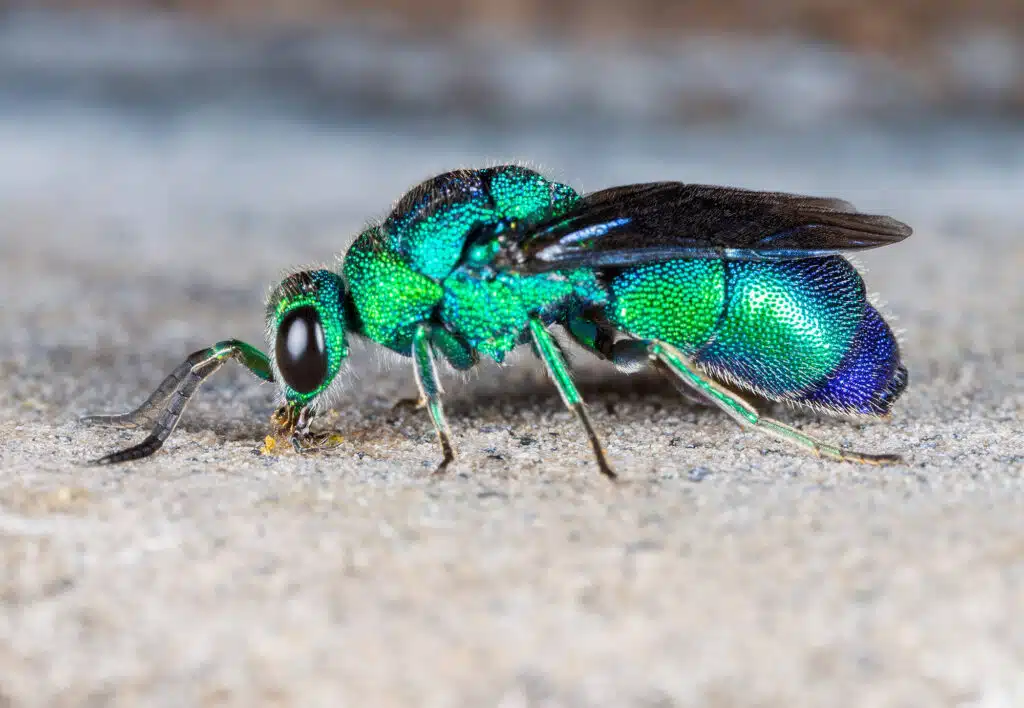
A glossy and slightly metallic blue-green color is characteristic of these types of wasps (Chrysis angolensis).
This species has uniform coloring across its body and large black compound eyes.
Metallic Bluish-Green Cuckoo Wasps have been accidentally introduced to new territories across the world such as North America.
This is why the species cans how a detrimental status here as the females repurpose the nests of other species.
Unlike many native wasps, The Metallic Blue-Green Cuckoo Wasps also show a tendency to have different defensive habits.
These are wasps that curl up when under threat. This is a defensive mechanism mostly seen in females.
Blue nuance – metallic blue-green
17. Emerald Cockroach Wasp
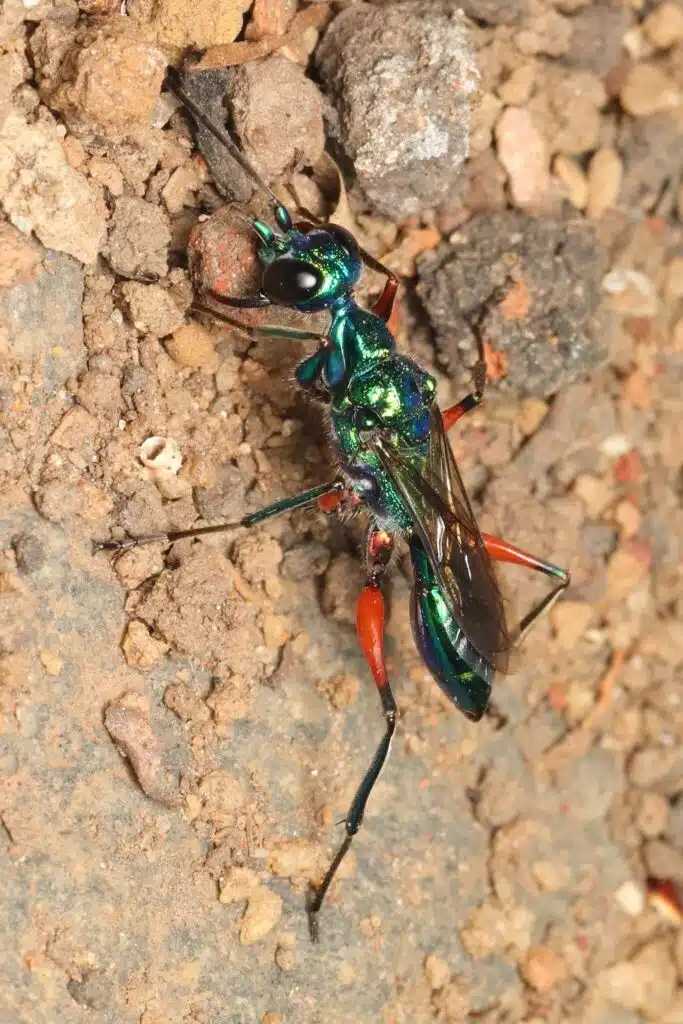
Blue and emerald-blue colors dominate the appearance of The Emerald Cockroach Wasp (Ampulex compressa).
The vivid metallic colors of the wasps are further contrasted by red sections across their legs.
Short white hairs can also be seen on adult Emerald Cockroach wasps, a species that only lives for several months.
A native species of Asia, this wasp is named after its tendency to eat cockroaches. It stings roaches and it paralyzes them to serve them as food for its larvae.
Cockroaches a few times larger than the wasps are stung by Emerald Cockroach Wasps which chew off their antennae to make them unable to move.
Wasps of the species carry the bugs back to their nests while grabbing them either by the head or by the remaining antennae for the emerging larvae to feed on.
Blue nuance – emerald-blue
18. Currant Orchard Bee
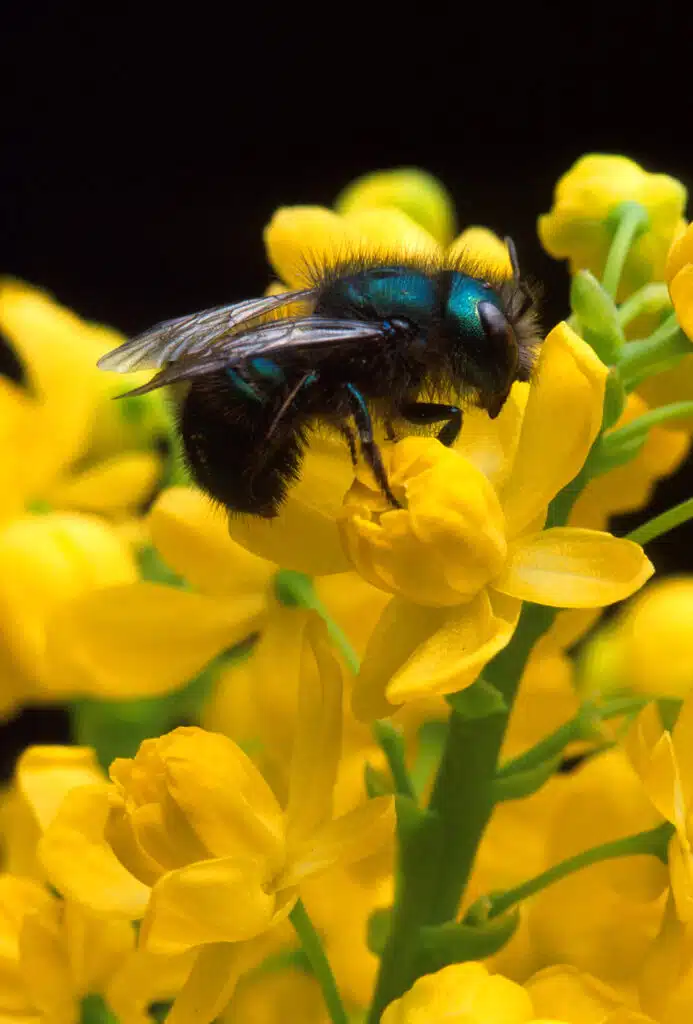
Current Orchard Bees (Osmia ribifloris) have a blue-green nuance of an almost emerald appearance. This metallic-looking bee is not a rare sight in Western US states.
It can be found on crops and in gardens where it plays a considerable role in plant pollination.
Manzanitas, blueberries, and cranberries are among the most common plants it pollinates.
These bees aren’t strangers to other plants as well. Since they fly low, they prefer short plants and shrubs.
The success in blueberry pollination has also led to Currant Orchard Bees getting a name for themselves.
Found in specialized stores, Currant Orchard Bees can be purchased as an effective species that pollinators blueberries.
Blue nuance – blue-green
19. Blue Orchard Bee
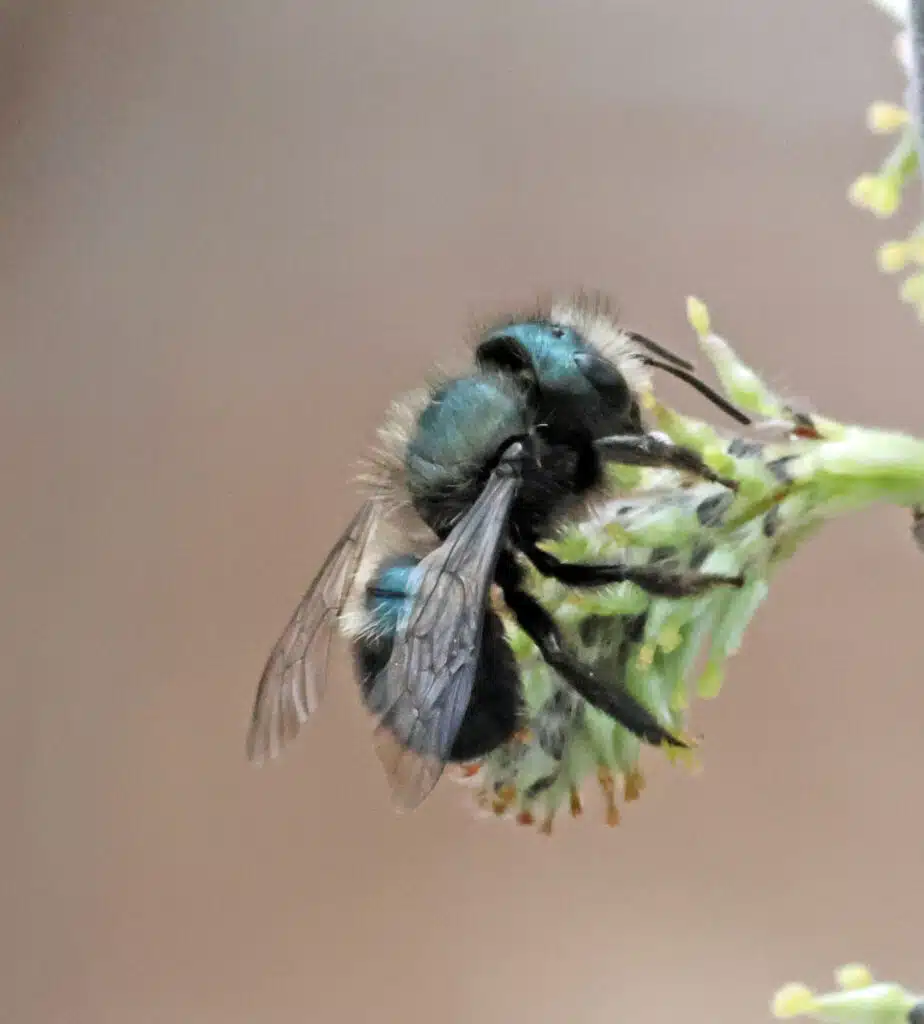
Various blue shades are specific to The Blue Orchard Bee (Osmia lignaria). These bees have metallic blue, blue-purple, and blue-to-green coloring.
Its complex metallic colors are only easy to perceive in direct sunlight.
Many Blue Orchard Bees have purple-tint abdomens with a metallic green tip. Others are mostly blue.
This species builds mud nests and it uses mud to create nest cells. These individual cells are where their eggs are laid and where larvae emerge in the spring.
Females of the species are responsible for building these types of nests and they prefer to build their own rather than repurpose old nests.
Bees of this species also show a positive impact as pollinators. They are available commercially.
Blue nuance – dark blue
20. Condylostylus mundus
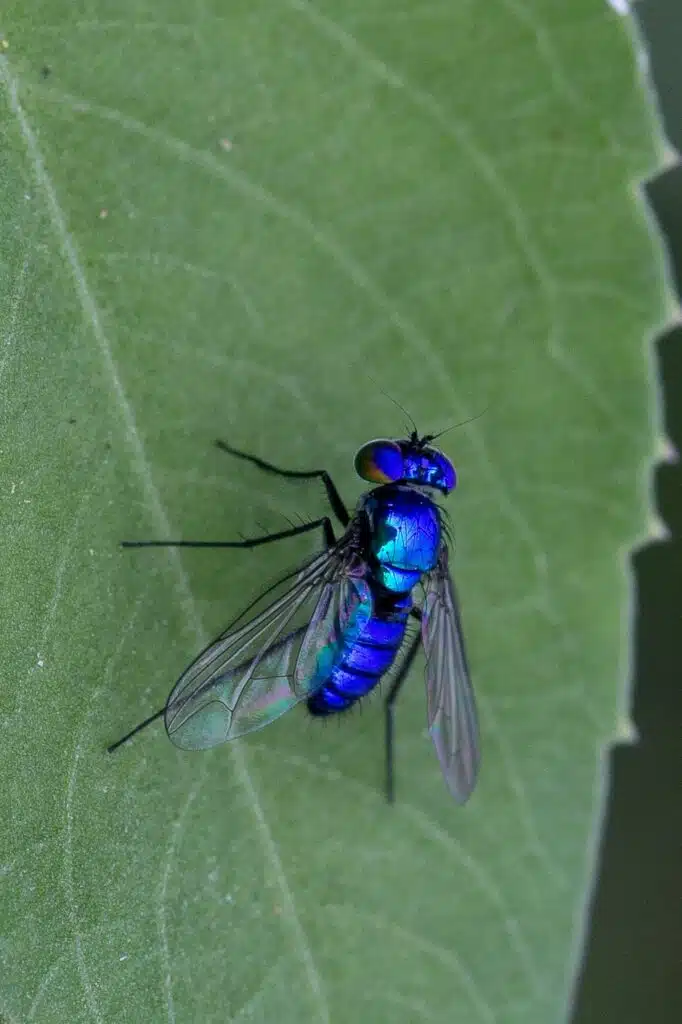
Blue nuances dominate the appearance of this rare bee. Dark blue and bright, blue nuances are seen on its thorax and abdomen.
The thorax of the species is dominated by brighter blue nuances.
Bright metallic blue is seen on its thorax while its abdomen also shows metallic nuances. Even the eyes of these bees are dark blue.
Morph variations include green and blue Condylostylus mundus.
Females of the species lack the blue nuances seen as males are dominated by glossy green coloring.
This bee species isn’t as present in North America as in Central America as it only makes its way to the Southern US states.
Blue nuance – dark blue, bright blue
21. Shiny Blue Bottle Fly
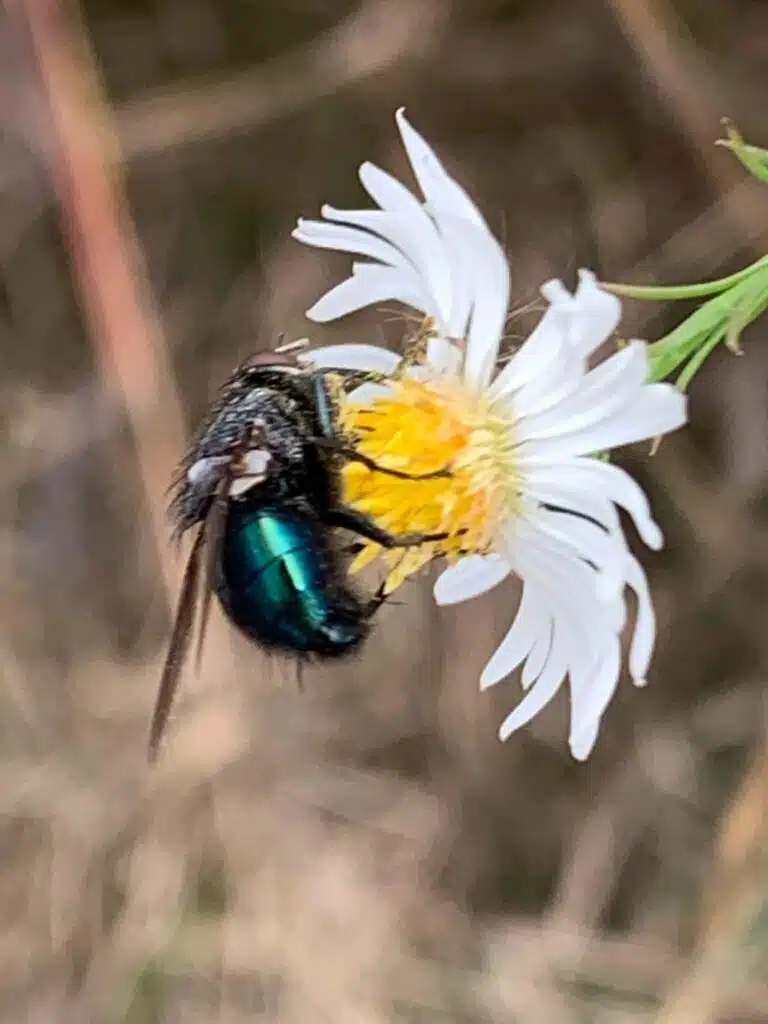
These types of flies (Cynomya cadaverina) are known in North America in the spring months. High activity of Shiny Blue Bottle Flies is also seen in the fall when they seek refuge.
These types of flies are dominated by a blue-green nuance backed by a black body color while their wings are transparent.
Shiny Blue Bottle Flies only appear on carrion and dung. They inhabit forests, orchards, gardens, and plenty of other areas where animals live.
While also seen as far South as Texas, it is a species that lives in higher numbers in Northern US states as well as across Canada.
Blue nuance – metallic blue
22. Blue Blowfly
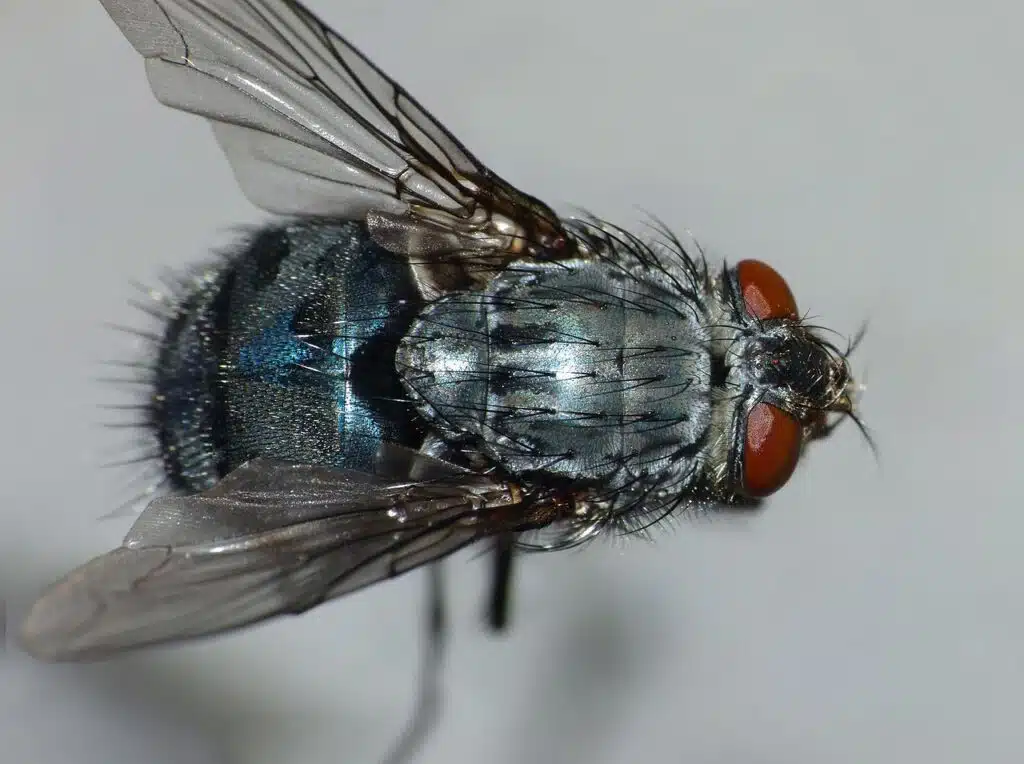
A blue type of fly with black and blue underside colors, Blue Blowflies (Calliphora vicina) are found on carrion and on corpses.
These types of flies lay eggs on corpses and are among the typical species forensic experts rely on when it comes to clearly establishing the time of death.
Blue Bowflies only lay eggs on dead corpses and these eggs then turn into larvae.
Experts typically assess the size and the development stage of the larvae to statistically determine the time of death.
These types of flies with brown eyes are further known to feed on pollen. They can even help pollinate plants but they can further transmit bacteria both to plants and to humans.
They do not lay eggs on plants, on the other hand.
Blue nuance – dark blue
23. Blue-green Bottle Fly
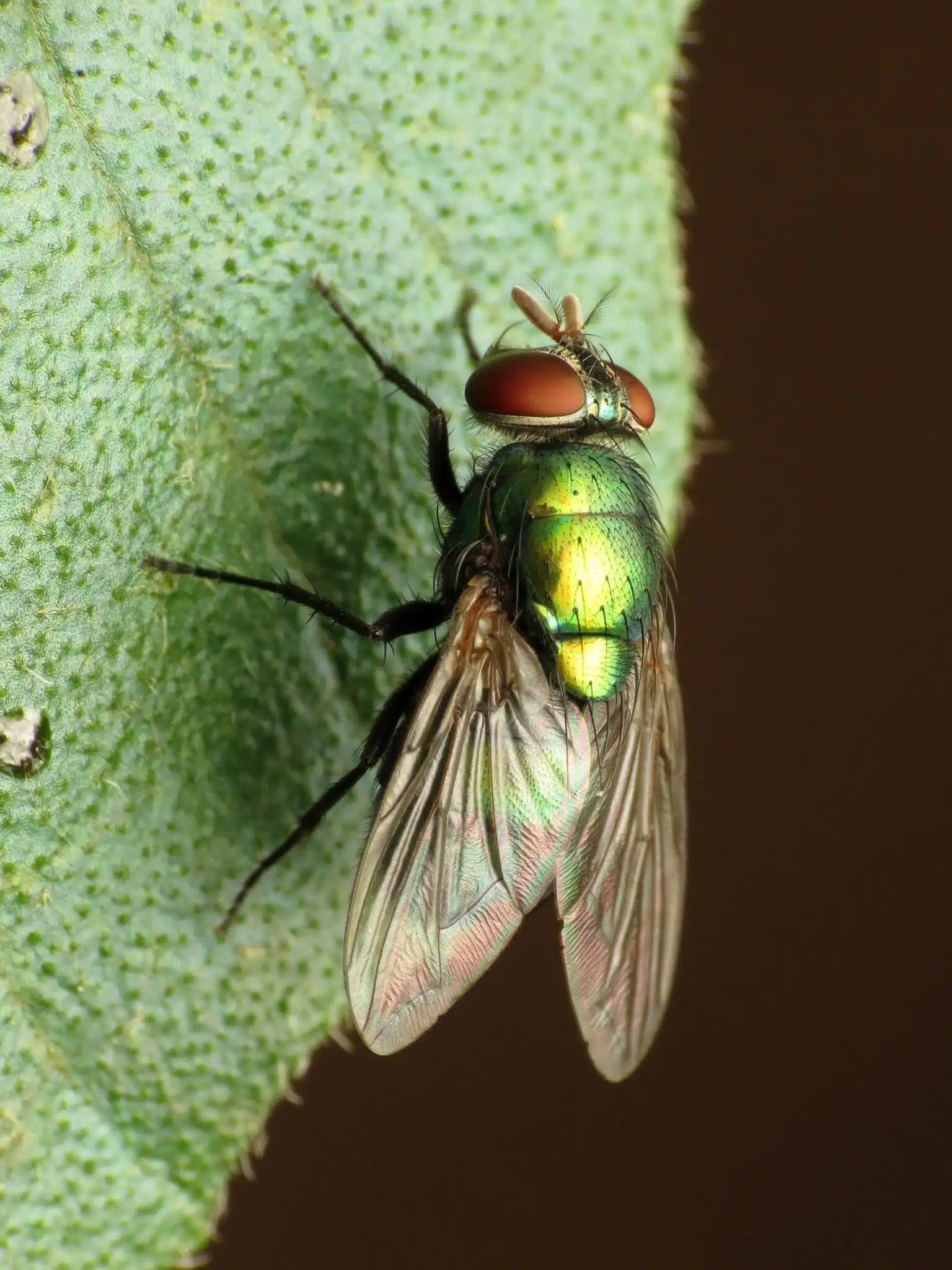
Metallic blue and green nuances make up the dorsal appearance of Blue-green Bottle Flies (Lucilia coeruleiviridis).
These types of flies are smaller than Blue Blowflies but still share some of their feeding and breeding habits.
Blue-green Bottle Flies lay eggs on carrion and corpses. The emerged larvae feed on corpses until they emerge as adults.
While adult Blue-green Bottle Flies may also feed on corpses, these types of flies can also consume plant nectar and pollen.
Strongly guided by smells and odors, Blue-green Bottle Flies may feed on the pollen of some of the most fragrant plants in the absence of corpses or carrion.
While these flies lay eggs on carrion, they can mate on plants and on other surfaces.
Blue nuance – blue-green
24. Blue Dasher
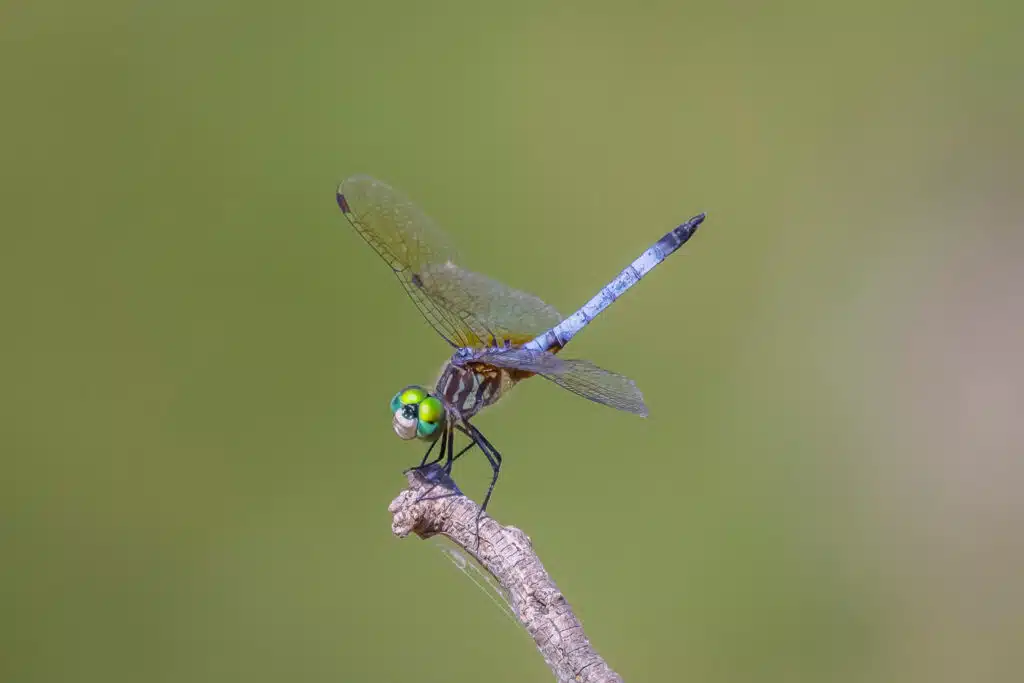
As multiple species of dragonflies, Blue Dashers (Pachydiplax longipennis) show clear coloring differences between males and females.
The male dragonfly is dominated by blue nuances, combined with black and white sections.
While also partly blue, female Blue Dashers are mostly yellow and black with large brown eyes.
The appearance of the wings is one of the few similar sections of males and females. Transparent wings with black veins are specific to these dragonflies.
Like most other dragonflies, Blue Dasher Dragonflies inhabit areas next to the water. From streams to ponds, water sources are known to attract the species.
Blue nuance – bright blue
25. Ebony Jewelwing
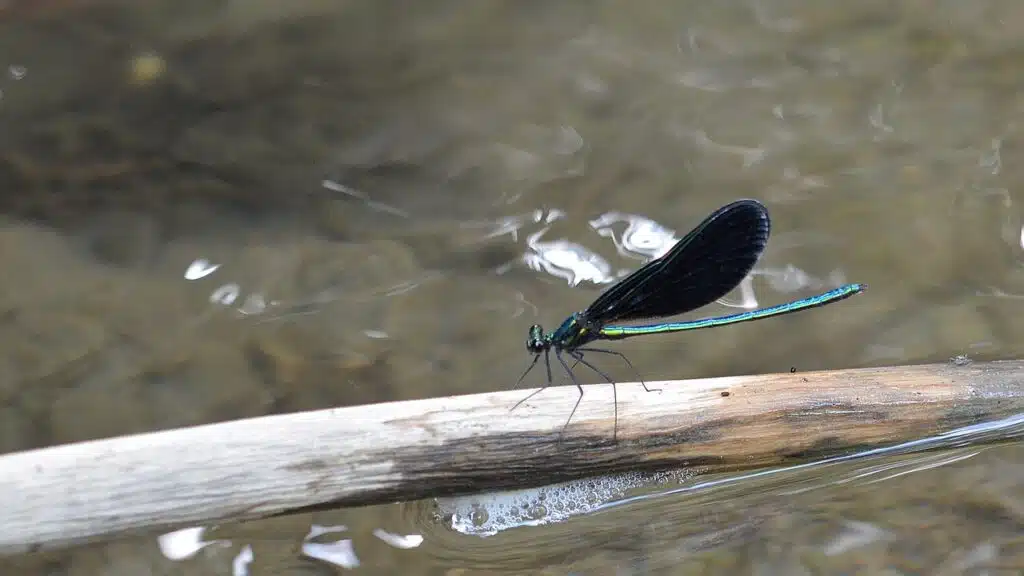
A species of damselflies, Ebony Jewelwings (Calopteryx maculata) may sometimes be confused with dragonflies.
While they share a similar body shape, Ebony Jewelwings differentiate themselves through the uniform color across the body.
This is a metallic blue species with similar head and eye coloring. Unlike dragonflies which often show black segment margins, these damselflies have a uniform appearance.
Ebony Jewelwings of the species still show small nuance differences between males and females.
The female of the species may either show a darker blue nuance or a mostly brown appearance.
While they can also share the same habitat with dragonflies close to water, Ebony Jewelwings can also survive away from water.
They might come to the water for food. As predators, Ebony Jewlwings feed on small insects such as mosquitoes.
Blue nuance – metallic blue
26. Familiar Bluet
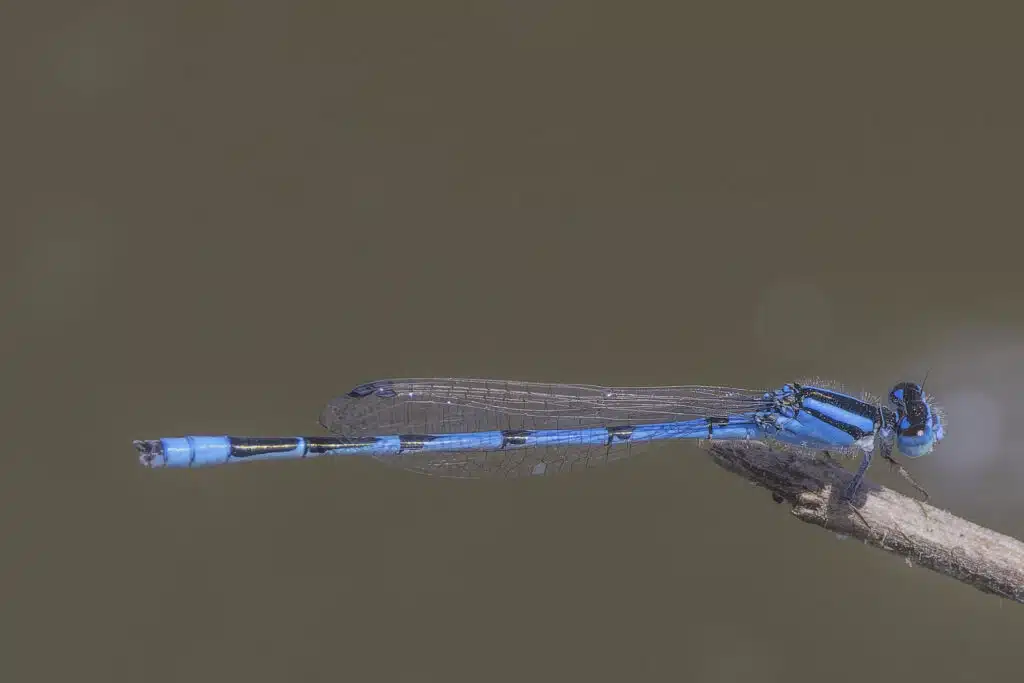
Male Familiar Bluets (Enallagma civile) are among the brightest types of blue bugs. A bright blue color dominates their appearance, together with black colors on the segments of the margins.
The thorax of the species is also mostly blue while the head has blue and black coloring.
Bright blue or dark blue eyes are also specific to the male.
Females of the species are darker and dominated by nuances of brown.
This is a species known for coming together into a heart shape when mating. Males and females mate in the air and they may even continue flying while mating.
Blue nuance – bright blue
27. Blue-fronted Dancer
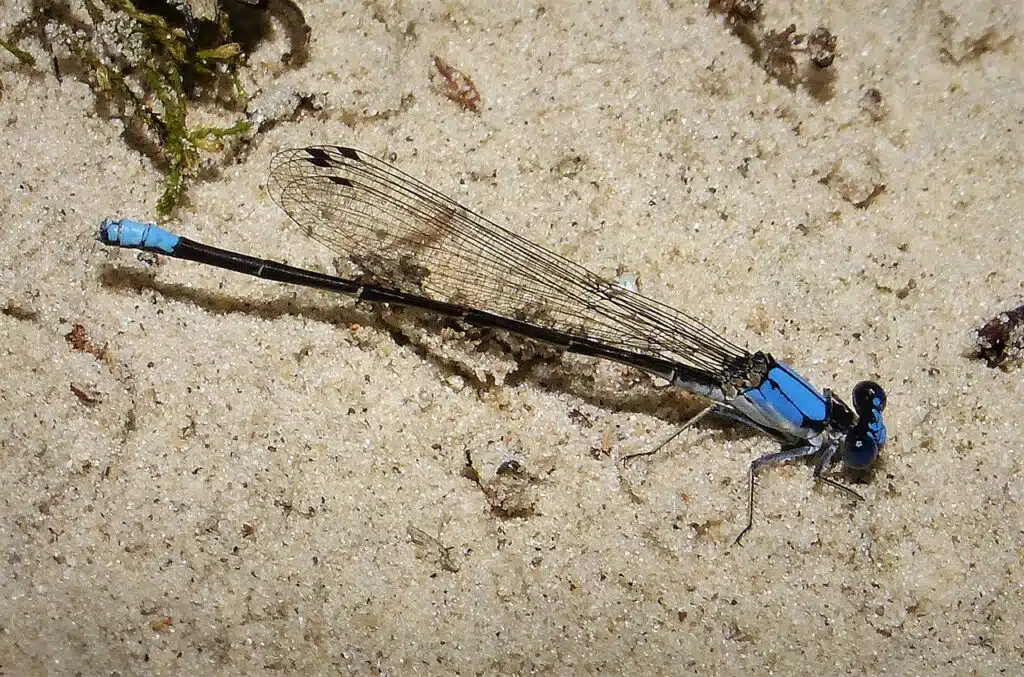
Named after the appearance of males, Blue-fronted Dancer (Argia apicalis) damselflies are blue. A bright blue nuance separated by black section margins is specific to these damselflies.
Females may also be blue, but only in a given stage of their lives and to a lesser extent than males.
The female body is dominated by gray, brown, or black nuances. Blue is also the color of the thorax before it changes colors in females.
Found just above the water, flying for food and mating partners, Blue-fronted Dancers are seen in the second half of the summer.
Their range is extensive. These damselflies live in small groups but in a widespread habitat from Canada to Southern US (except California).
Blue nuance – bright blue
28. Polka-Dot Wasp Moths
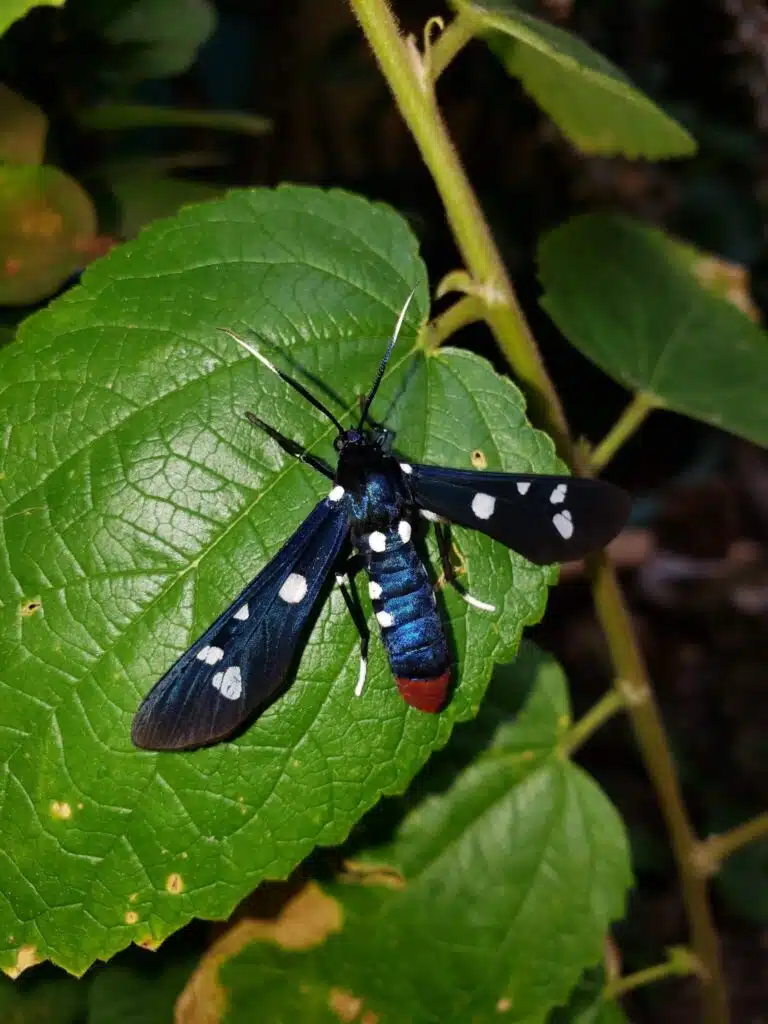
A tropical and sub-tropical species, Polka-Dot Wasp Moths (Syntomeida epilais) are named after their spotted appearance.
These types of warm climate moths are dominated by dark nuances such as navy blue and black.
A few white dots contrast their appearance, together with an orange-red abdomen tip.
A species found in The Americas, Polka-Dot Wasp Moths are further seen in Florida. This is a species that may also show some nuance variations.
Its wings can be black but they may also have a shiny dark blue nuance, depending on its life stage and region.
Blue nuance – dark blue
29. Nine-spotted Moths
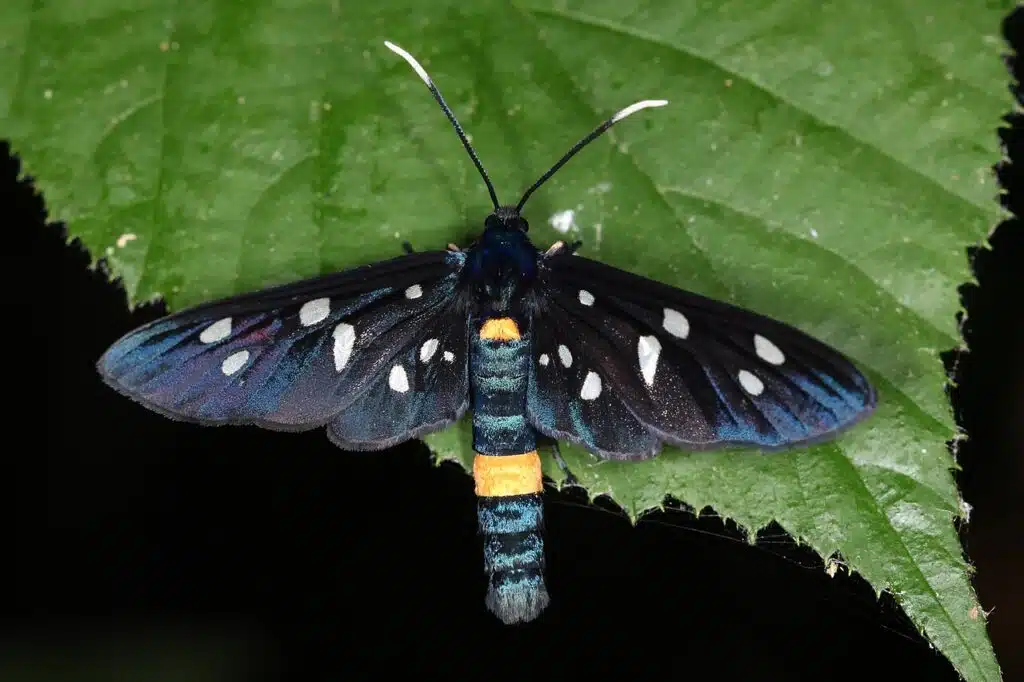
Starting life as a furry gray and black caterpillar, Nine-Spotted Moths (Amata phegea) emerge as dark-spotted adults.
A species named after its white contrasting dots, this is a moth that has black and blue or black and green coloring.
Mostly common in Europe and Asia, this is a species that may have dark blue or bright blue inner wings while its outer wings might be black.
The species also shows either bright blue or dark blue body coloring with additional black sections.
A yellow abdomen band tends to contrast its darker appearance.
A late species in the season, this moth emerged in August and is commonly seen as it has some of the most common plant hosts such as plantains.
Blue nuance – bright blue, dark blue
30. Western Grapeleaf Skeletonizer Moth
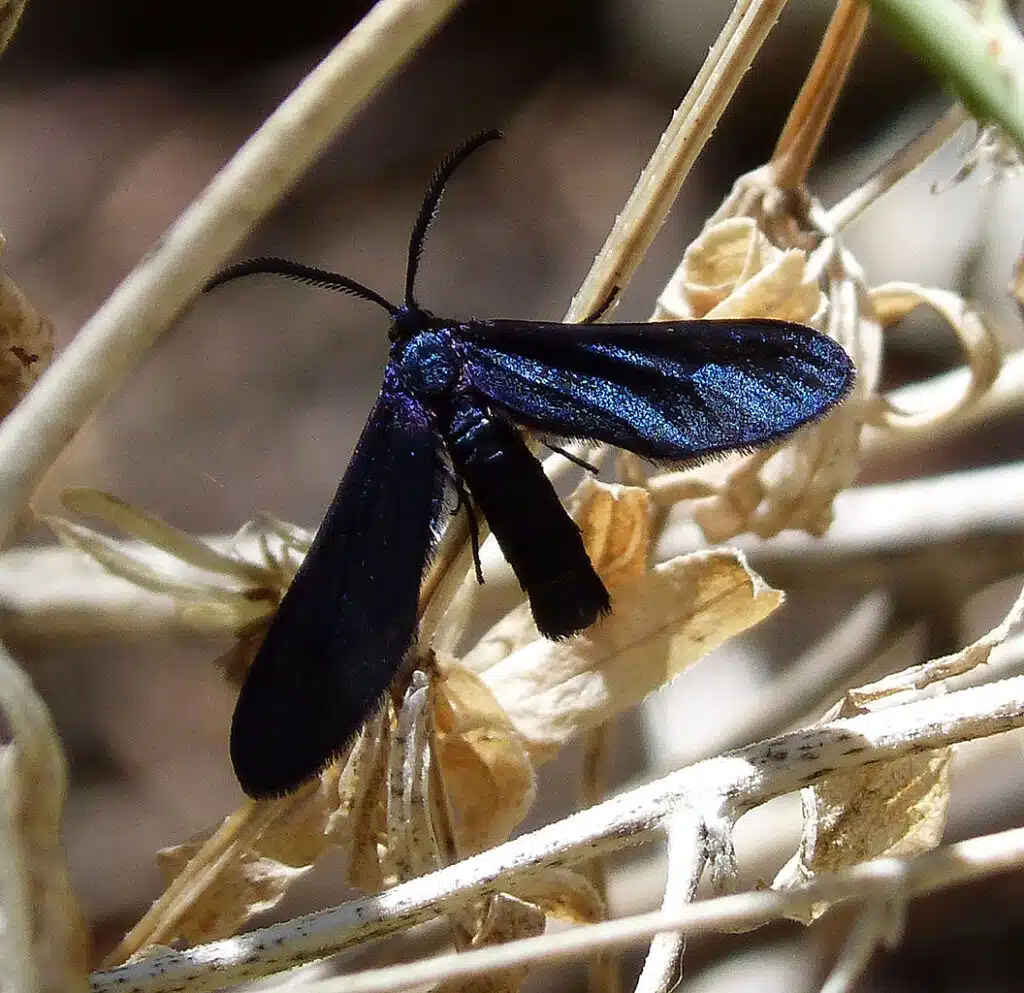
A black-appearing moth, The Western Grapeleaf Skeletonizer Moth (Harrisina metallica) has dark blue coloring.
This is a color characteristic of both its body and its wings.
A pest species, these moths and their caterpillars damage cultivated grapes and invade vineyards.
The mostly yellow caterpillar feeds on the leaves of grapevines while adults have a preference for the grapes themselves.
Proper management is required when it comes to keeping the moth away. Some of the areas at the highest risk of an invasion include Southern and Southwestern US areas from California to Texas.
Blue nuance – dark blue
31. Red-spotted Admiral
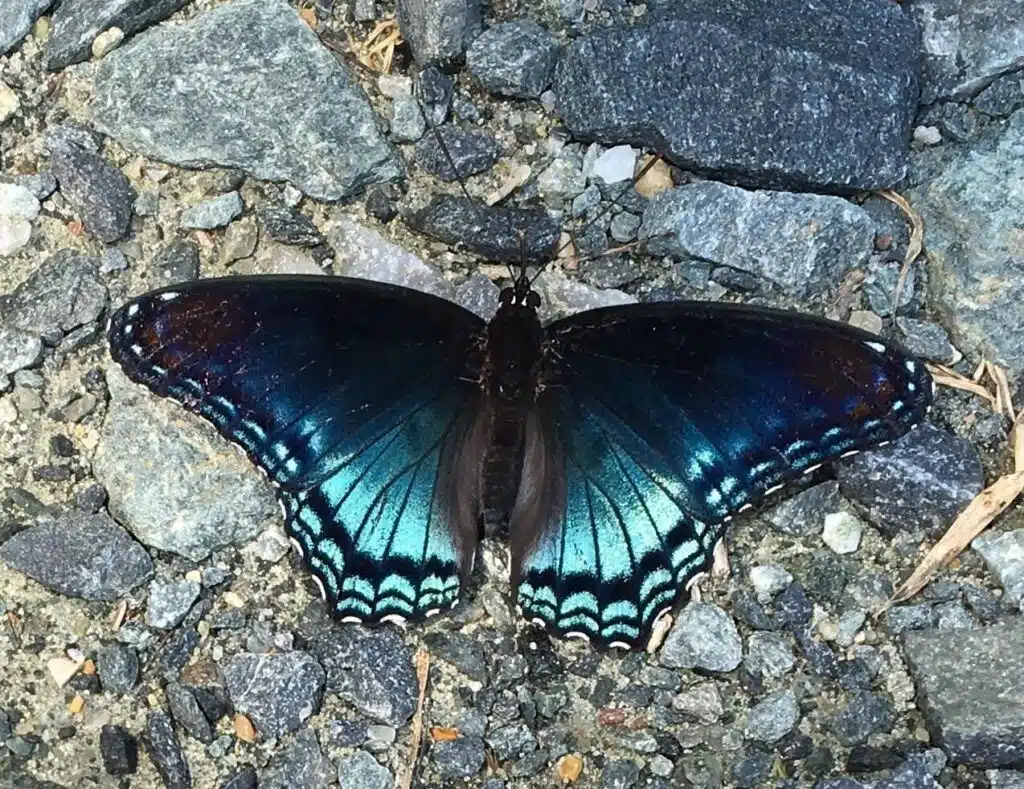
Dark blue and bright blue colors are also seen on butterflies. Multiple species of North American butterflies have at least partial blue wings.
Red-spotted Admirals (Limenitis arthemis) stand out as they have both dorsal and ventral blue wings.
While the amount of blue coloring varies, its dorsal wings show dark blue or black forewings with bright blue hindwings.
A bright blue color is specific to its ventral wings.
A species named after the colorful contrasting spots at the margins of its wings, this is one of the multiple butterflies with peculiar mating habits.
Males of the species are seen actively looking for areas with multiple females to increase their chance of finding a mating partner.
Blue nuance – bright blue, dark blue
32. Holly Blue
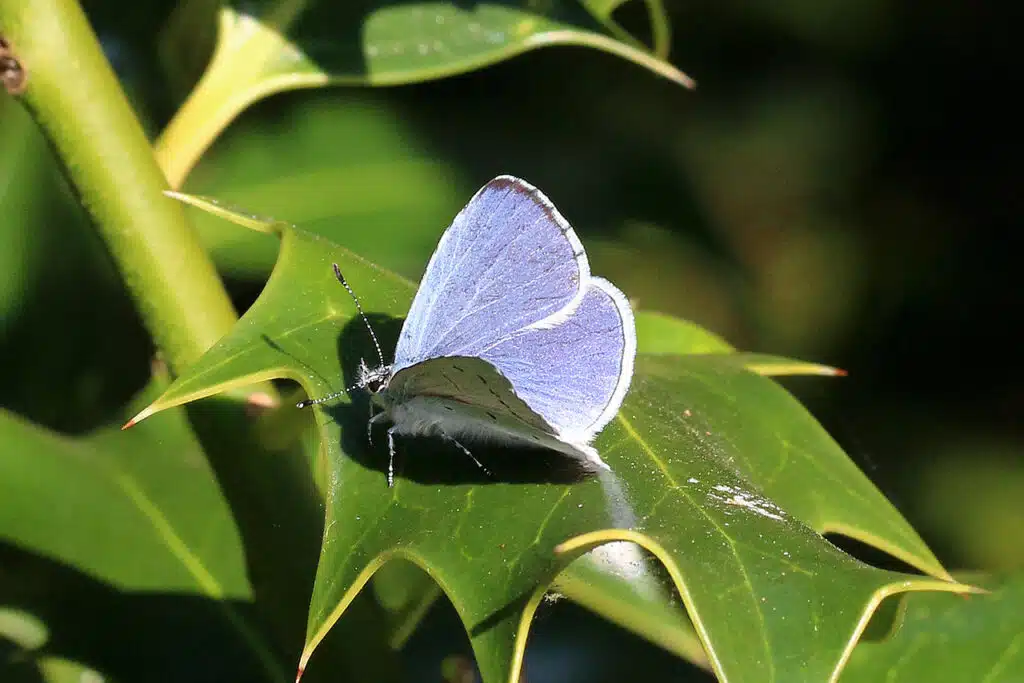
One of the earliest species of butterflies to emerge in the season, Holly Blue (Celastrina argiolus) is a bright blue butterfly with a common nature.
This a species that emerges in the spring and impresses with its dorsal and ventral blue wings.
Both sides of its wings are blue but they differ in nuance. Bright blue dorsal wings with black margins are specific to its dorsal wings.
Its ventral wings are very white, with hints of gray and blue. Black spots contrast the bright ventral view wings of the species.
There’s nothing to announce these bright blue colors of the wings as the Holly Blue Caterpillar has a salmon-pink nuance in its grown stage.
Blue nuance – bright blue
33. Long-tailed Skipper
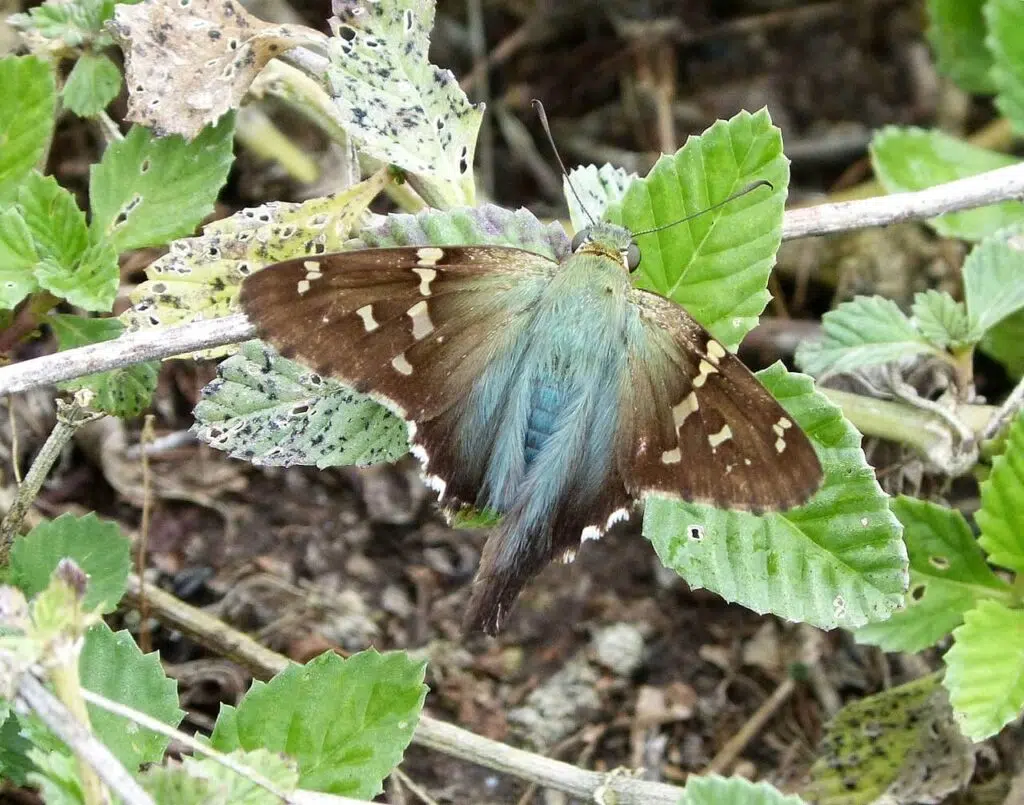
Butterflies of America can live both in tropical and temperate climates. Some species such as The Long-tailed Skipper (Urbanus proteus) are known for their high adaptability.
Despite not being seen in areas with cool weather for too long, this is a species that spreads its habitat from tropical climates to the Eastern side of The United States.
Apart from its habitat, The Long-tailed Skipper stands out with its blue body, central wings, and long blue tail.
Spotting the butterfly might be a distinct moment based on its colorful wings but this species is actually a pest. Its caterpillar feeds on beans and leaves.
Blue nuance – iridescent blue